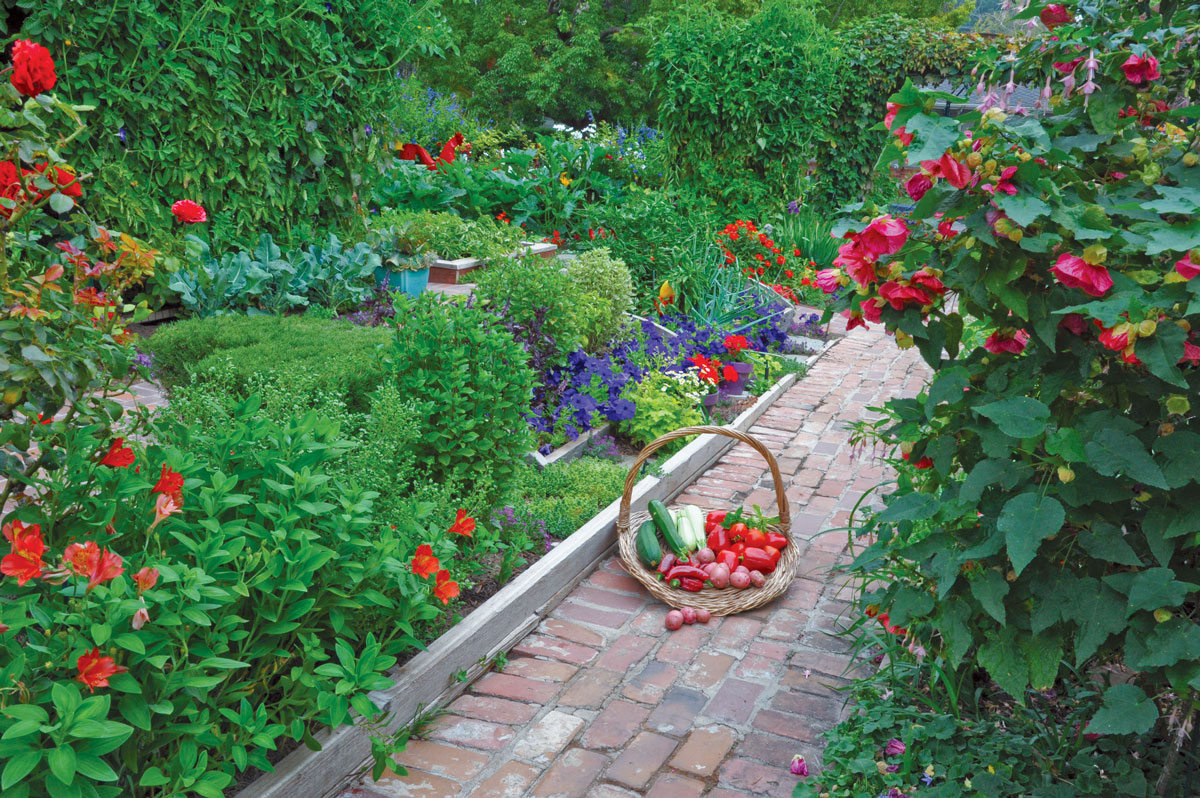Edible Gardening: A Conversation with Rosalind Creasy
My conversation with Rosalind Creasy began in a cool corner of a library. My children and I made our weekly trek to the local library to dodge the hot arrows of a fierce Oklahoma sun. Our rule was to each select one book that was new to us.
Nathan, age 4, selected Where the Wild Things Are. He picked out Goodnight Moon for his sister Ellen, who at 2 was still a little young to choose on her own.
Then it was my turn. Lunchtime approached and I knew I had to act quickly. As the kids settled into their books I asked the librarian, “Where are the gardening books?”
“What kind of gardening?” she asked.
I thought for a moment. Most of what I knew about gardening came from Grandmother. She handed down her books on roses and perennials to me, her preferred garden genre in her later years. Though she knew a great deal about vegetable gardening, an edible garden reminded her of the dusty years of the Great Depression. Not only had her family fed themselves from their family farm, they had fed migrant workers and other neighbors.
She made new memories with Tropicana roses and lush lavender plants and taught me as we walked and watered in my childhood summers. When I asked her about growing tomatoes she responded, “Oh, just go down to the Piggly Wiggly and get some there.”
I looked at my children engrossed in their books. “How about something about vegetables?” I asked the librarian.
She led me to a row of books and pulled from the stack a slim blue volume called The Complete Book of Edible Landscaping by Rosalind Creasy. It didn’t have the heavy, encyclopedia look to it. A quick glance told me that it was small enough to lug around with toddlers, yet meaty enough to keep me occupied. I added it to our book pile.
My grandmother and I, like other gardeners, identified edible gardens in the traditional way: rows of corn, peppers and tomatoes kept in the back yard, far from the splashy and stylish flower gardens.
Rosalind’s way was different.
Her ideas of using edibles throughout a landscape, even in a front yard, were a radical new approach. Instead of relegating edibles to the usual long rows or brown raised beds, she incorporated her edibles throughout her designs. The results were a stunning array of color, design and function.
From that first encounter, I have continued to read Rosalind’s books, almost all 18 of them.
Rosalind has always been ahead of her time. It was she who said “We can go back to basics; there were fabulous gardens before the invention of gas-powered machines and artificial chemicals and there will still be fabulous gardens after these accouterments of modern gardening have been set aside.”
As my children grew, so did my garden. Each time I began a new phase, started a new garden or just needed inspiration, I consulted Rosalind in one of her many books. My children are now 24 and 26 and they have been a part of all my gardens. They have even started their own.
So the conversation continues.
I’d like to report that with Rosalind’s books by my side, my gardens looked just like her award- winning photographs that adorn her books. While I have had successes I have also had my disappointments. At each opportunity to seek advice from her books, I found her ideas creative, her style straightforward and her advice approachable. This inspires her students to believe in themselves. She gives encouragement where others might give lectures.
Gardening is a dance with nature and often I trip over myself with questions. I find Rosalind’s answers easy for me to hear and to want to try again. I take comfort in quotes such as “Your garden may appear to be a quiet place, but in reality it is an arena where hundreds of life-and- death dramas are played out every day. Birth and death, killing and nurturing, even intrigue and cunning are all part of the complex community of life waiting to be discovered—and sometimes struggled with—in your garden.” (Edible Landscaping by Rosalind Creasy. Sierra Club, 1982.)
Such insight reminds me that gardens often teach us more in our failures than they do in our successes, a lesson that helped me not only to garden well, but to live well.
Recently, I had an opportunity to talk with Rosalind in a real, one-on- one discussion, where she could hear me and answer my questions in “real time.” I found her to be as helpful and encouraging as her books.
Rosalind began gardening at the age of 5 when the gardening tasks were delegated to her by her father, who traveled on business a good part of the time. “It fell to me by default as I was the only one interested in gardening.” Her father gave her five- by five-foot plot, right next to his, and allowed his daughter to do whatever she wanted, even moving plants around.
“I treated it like my dollhouse and I learned the best way: by doing. My father never told me ‘don’t do this’ or ‘don’t do that.’ I just learned by watching him and by learning alongside him.”
Her gardening education has evolved over years of watching gardens from Israel to Milan, all fueled with a desire to create beautiful, yet functional edible gardens. She spends three to four months a year on the road, giving presentations, doing research, taking photographs and visiting folks passionate about homegrown edibles—especially gardeners who cook and cooks who garden.
Her ideas have not always been well received. When the horticulture communities scoffed, she decided to show, not tell. She removed the sod from her front yard and set about designing a front lawn edible landscape complete with chickens.
Rosalind contends that design must take a starring role in the creation of edible gardens. “You have to show your neighbors that you have a plan, a design that is artful. You don’t simply just take rows and beds and move them to the front. You use skill.”
She advocates gardens with solid design principles of unity, line, scale, balance and simplicity. Perhaps this is why Rosalind’s ideas are so appealing: She gardens where art and science intersect.
Little wonder that visitors find their way to Rosalind’s garden. In fact, she joked in our telephone conversation, “If you don’t want your neighbors in your yard, don’t landscape with edibles.” It is common to find the neighbor children in her front garden, especially since her chickens are housed there.
Edibles used in a front yard challenge even the most skilled gardeners. “What does it look like in the winter?” is often asked in Rosalind’s classes. Her response? “Much better than a big patch of brown grass in midwinter.” The use of low-growing plants combined with well-designed beds and paths make any landscape more appealing.
In person or on the page, a conversation with Rosalind always brings me inspiration and new questions. What could happen if the lawns of today were reconsidered to be places of community and shared food? How many families might find solace and comfort as they shared the day’s events while munching on fresh strawberries picked from the vine?
What other mother might find a way to nurture her own children—even herself—as the conversation continues?
STARTING SMALL: A STRAWBERRY BARREL
Rosalind suggests that gardeners new to edible landscaping focus on starting small. Container gardening is a great way to try new ideas. Here is an excerpt from her book Edible Landscaping on how to grow a strawberry barrel. A wine barrel, painted a vivid color can be a great start to enjoying beautiful and edible gardens.
MATERIALS:
- Drill with 1/2-inch and 2-inch drill bits
- A large wine barrel cut in half horizon tally, measuring 42 inches wide and 24 inches tall
- 1/2-inch solid distribution tubing, cut to length as needed
- 1/4-inch tubing with laser cuts or in-line emitters spaced every 6 inches, approx. 30 feet
- 1/2-inch end cap
- 1 bag of 1/4-inch connector barbs, Ts and goof plugs
- Soilless potting mix, 3 bags, each 2 cubic feet
- All-purpose organic fertilizer
- Homemade compost, worm castings, compost tea or other source of microbes 24 day-neutral strawberry plants (Tristar strawberries bear for many months and send out fewer runners than many other varieties.)
INSTALLATION:
1) Drill seven 1/2-inch drainage holes, evenly spaced, in bottom of barrel. Then drill nine 2-inch holes nine inches up from base of barrel, spaced nine inches apart. Drill another row of nine holes nine inches up from first row, staggered between holes in lower row.
2) Connect 1/2-inch solid distribution tubing to closest water source and run it to barrel. Measure length of emitter tubing long enough to go around inside of barrel at least six times; connect it to solid distribution tubing. Thread unattached end of emitter line through one of lower holes, and bring it up out of barrel.
3) Add soilless potting mix up to lower level of planting holes. Following package directions, sprinkle one-third of recommended amount of fertilizer along with compose, worm castings or other bacterially active material, and mix it in.
4) Set one strawberry plant in each hole; to avoid air pockets, press plant in place and gently pack mix around it. Lay ring of emitter tubing around plant roots and secure it with irrigation stakes.
5) Repeat steps 3 and 4, setting plants in higher row of holes. Bring emitter tubing up through soil and circle it around roots.
6) Fill barrel to within 1 inch of top with potting mix, add fertilizer and compost or other material and mix together. Plant remaining strawberries six inches apart and firm into place.
7) Bring emitter tubing up, loop it around inner edge of barrel and weave it among plants and towards middle of barrel. Turn on irrigation system; flush out any debris in line. Once line runs clear, plug end of emitter tubing with goof plug.
8) Mulch with few inches of compost; work it around plants. Use gentle spray nozzle to softly wet soil; repeat at least three times to completely saturate entire barrel. For next few weeks—until plants start to put out new growth—keep soil lightly moist but not soggy. Once plants are growing well, use new irrigation system.
This weekend project will provide enough fruit to top your cereal all summer long.
(Source: Edible Landscaping by Rosalind Creasy. San Francisco: Sierra Club, 1982. pp 148–149.)






